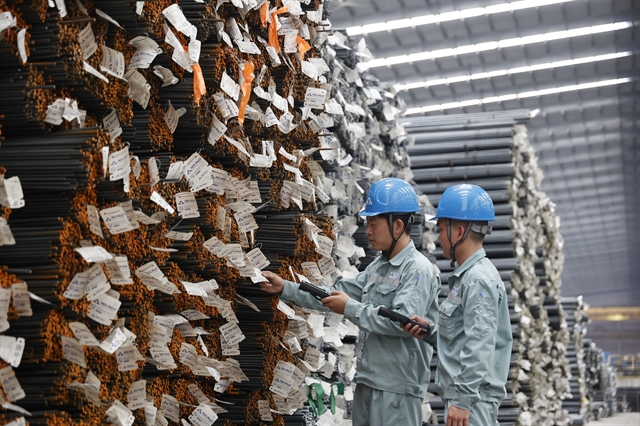 Society
Society

Erosion and subsidence along canals, rivers and coasts have been severe in many areas in the Cửu Long (Mekong) Delta and local authorities are struggling to raise funds for works to prevent them.

|
| Erosion along the Tiểu Dừa coast in Kiên Giang Province’s An Minh District is severe. – VNA/VNS Photo Lê Huy Hải |
HCM CITY Erosion and subsidence along canals, rivers and coasts have been severe in many areas in the Cửu Long (Mekong) Delta and local authorities are struggling to raise funds for works to prevent them.
Cà Mau Province has around 1,000 such sites along canals as hot weather and drought have caused most canals to dry up, according to the province People’s Committee.
In Trần Văn Thời District, a 120-metre section of the western coastal dyke in Khánh Bình Tây Commune was washed away last Tuesday. The section was two metres wide in some places.
Lê Phong, chairman of the district People’s Committee, said warning boards have been set up at the eroded section to warn traffic.
Work to upgrade the dyke, which stretches 72km from Tiểu Dừa coast bordering Kiên Giang Province to Cái Đôi Vàm Town, has been estimated at more than VNĐ1.7 trillion (US$72.7 million).
But the province is currently only building a 49km section from Tiểu Dừa to Sông Đốc Town because of the lack of funds.
The dyke plays an important role in preventing coastal erosion and protecting thousands of farming households.
In neighbouring Kiên Giang Province, there are 14 coastal erosion sites adding up to more than 92km, according to its Department of Agriculture and Rural Development.
The province needs more than VNĐ2.16 trillion ($92.9 million) to fix the problem.
It has so far mobilised funds to address 25km of erosion.
Kiên Giang has a coastline of more than 200km, which is protected by 130km of dykes and another 70km of dykes which double up as roads.
The dykes are built with soil on coastal mudflats.
Nguyễn Văn Tâm, director of the provincial Department of Agriculture and Rural Development, said the mudflats are not stable and shift regularly.
To cope with climate change and coastal erosion, the province has built breakwaters in some eroded coastal areas to create mudflats for growing protective forests.
In An Giang Province, authorities are assessing erosion-prone and subsided areas to take measures to secure people’s safety and properties.
An Giang has 52 river and canal sections with erosion warning levels ranging between average to extremely dangerous, according to the province’s Department of Agriculture and Rural Development.
Last year it had 46 erosion and subsidence spots along canals and rivers with a total length of 3.4km, causing four houses and a part of another to fall into a river and 146 households to move to safer areas.
They caused losses worth VNĐ32.6 billion ($1.4 million).
Drought and saltwater intrusion
A number of provinces in the region are also seeking funding from the Government to battle the effects of drought and saltwater intrusion.
Bến Tre Province has asked for more than VNĐ1.15 trillion ($49.4 million) to build projects to prevent saline instruction and supply fresh water for agricultural production and household use, according to the province’s Department of Agriculture and Rural Development.
The Bạc Liêu Province People’s Committee has asked the Ministry of Agriculture and Rural Development and the Ministry of Finance for VNĐ225 billion ($9.7 million) to dredge irrigation canals, pump irrigation water, and install more tap water pipes and automatic water monitoring stations.
In addition, Sóc Trăng Province has requested VNĐ1.37 trillion ($58.8 million) to upgrade and build saltwater prevention sluices, pumping stations and temporary dams, while Long An Province has sought VNĐ170 billion ($7.3 million) for the same facilities.
Võ Kim Thuần, head of the Long An Sub-department of Rural Development and Irrigation, said that drought and saltwater intrusion had affected 13,000ha of rice and 11,000ha of fruit in the province’s southern districts.
Long An authorities and farmers are building temporary dams and pumping irrigation water into fields to save rice.
The delta, which includes 12 provinces and Cần Thơ City, is facing severe saltwater intrusion during the dry season, which is expected to equal the record severe saltwater intrusion in 2016.
However, the damage from saltwater intrusion has been lower this year as the delta began preparations at the beginning of the dry season.
So far this year during the dry season, the delta has had about 20,000ha of rice damaged by drought and saltwater intrusion compared to more than 400,000ha damaged in 2016, according to delta’s statistics.
In a meeting held in Tiền Giang Province on Thursday, Lê Quốc Doanh, Deputy Minister of Agriculture and Rural Development, praised the delta’s steps to prevent and control drought and saltwater intrusion for the 2019-20 winter - spring rice.
The authorities’ early instructions for the winter-spring crop and farmers' strict adherence to planting schedules have helped to reduce the amount of damage. Fruit orchards in the delta have also been protected well, he said.
With the success of the winter - spring rice crop, proper sowing schedules for the next summer - autumn rice should be established, Doanh said, adding that provinces should also develop construction as well as non-construction measures.
In recent years, the delta has built many large irrigation projects to cope with drought and saltwater instruction, which have helped mitigate damages to agricultural production.
The Ninh Quới Sluice in Bạc Liêu Province’s Hồng Dân District, for instance, was put into use last year and has prevented saltwater intrusion and regulated irrigation water in shrimp - rice farming areas.
Thanks to the sluice, Bạc Liêu’s 48,000ha of winter - spring rice has not been affected by saltwater intrusion. The sluice cost more than VNĐ400 billion ($17.2 million). — VNS

.jpg)


